A NO-FRILLS PAGE OF ITEMS I CAN SUPPLY TO HELP YOU
BUILD YOUR OWN CRYPTO GEAR.
SOME IS HARD TO FIND ANYWHERE ELSE, SOME IS JUST
CHEAPER HERE!
ALL ADVICE IS GIVEN FREELY AND WITH NO GUARANTEES!
(under construction)
Many people around the world dream of organising their own research project or expedition, only to find that they can't locate the equipment they need. Here is a growing list of items useful in all kinds of projects - school, college and private research - that I can supply or direct you to.
This is not an electronics tutorial - I am not going to tell you how to use the items, beyond linking to various pages on my web site where they are described or mentioned. I have used many of the items in applications for which they were not designed, and no guarantees are given that the items will perform for you as they did for me.
Having experimented widely with Xenon flash tubes and massive lethal capacitors running at 450V and more in the past 30 years, and having survived, I will only describe the 12 volt dc equipment which I use in my wiser years. If you don't know how to use these components, please find someone who does, to help you.
TELEVISION CAMERA
I only supply one. Well... if this isn't
suitable, please ask me about the others...
 |
Spec: Sensor: 1/3 inch Black and White, 420
TVL, 0.01 lux, F2.0, Input 10 -13v, output 1v p-p, current 100 mA
approx., size 40
mm x 40 mm x 40 mm approx, lens focal length 3.6, 6, 8 and 12mm
available,
and the electronics inside the unit are rated to IP67 when used as per
the
instructions.
I normally modify the unit a little,
discard part of the mounting and generally invalidate the
manufacturers guarantee before use underwater. If you are also planning
to do that, I'll tell you what I did if you ask me! |
I have also attached supplementary lenses to the front, duct-taped the unit to binoculars, and even hack-sawed through the housing before attaching the sensor to a 300mm telephoto lens...the sensor is very sensitive to infra-red...the applications are unlimited! Use with up to 200m of RG59 ! Simply feed the video into your monitor, AV VCR input, or camcorder analogue input. See below for lighting.
£150 each.
HYDROPHONE
Arretec - Dolphinear
make the ones I use. Visit their site
for the
latest details. The basic unit consists of the compact amplifier shown
below,
a transducer on a length of high-quality audio cable, and a set of high
grade
ear pieces. You are also given instructions and a disk of data and
samples.
 |
This compact unit will enable you to listen to underwater sounds and record them too, with the addition of a suitable recorder. That could be a good old tape recorder with a mic input socket, a Minidisc digital recorder, a DAT recorder or even your PC / Laptop! If you bury the transducer* in the ground it will work as a geophone. Runs for ages off a small 9v internal battery. |
SOLUTIONS TO CABLING PROBLEMS
Camera too far away from the other end?
A VIDEO AMPLIFIER might
be the answer.
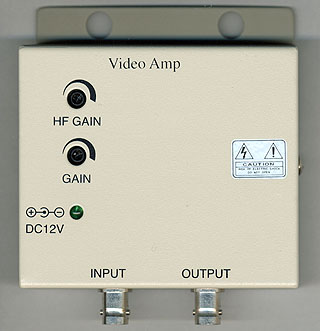 |
This one is 12 volt (10 - 13) d.c. powered, is 104 x 86 x 26 mm, draws about 20 mA and has a
max gain
of 20dB. Frequency range 1 MHz - 15 MHz. Place it as near to the camera
as
possible and use it to boost the video along your extra long cable. If
using
a sensitive recording device, take care to adjust the gain to avoid
overloading
the recorder. Try to avoid using it at the end of the cable opposite
the
camera - you will only be changing a weak noisy signal into a loud
noisy signal!
BNC input and output connectors.
The adventurous might try opening the box and incorporating the amp into their underwater camera unit. £70.00 |
Too many cables ? Want to send the power down the
same co-ax as the video is coming up? Here's a
POWER COMBINER & SPLITTER, each available
separately.
At the camera end, we have the SPLITTER
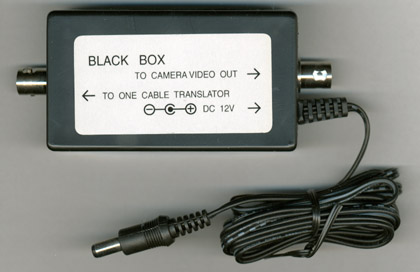 |
This clever device sorts out the video
signal going into the co-axial cable from the 12 volt power suply
coming out of it...so the one length of RG59 cable is all you need
running between the camera and the kit at the other end. Now you need
to be sure that the co-ax is resistant to mice, sheep, boats or
whatever strains you are putting on it! PCB measures 55 mm x 40 mm,
boxed item as shown measures 90 x 50 x 24 mm exc connectors.
£25.00 |
The COMBINER isanother unit which is installed at the monitor / recorder end of the cable, which sorts out the video signal coming from the camera, from the 12 volts (nominal) generated by the power supply within the mains powered unit.
£ ASK.
LIGHTING
Most applications need some. My comments here refer to usage with the underwater camera at the top of the page. In air, it can see objects several metres away by the light of a few infra-red diodes. It still works in this mode underwater, but the range is reduced. I can supply a 12 Volt 1.3A pcb fitted with 50 IR diodes for you to fit in your own housing for £125. I have used 5 watt lamps (motor car tail lamps) with quite good results, but if you are trying to film "scenery" rather than "wild-life" then I suggest about 20 watts of halogen lighting. Try to mount the light as far from the camera as possible - 50 cm if possible.
You can part with large quantities of money to obtain commercially built Underwater units, or you can "do it yourself". Salinity plays a major role in deciding what you can get away with underwater - any at all and you can have many problems, as salty water readily conducts electricity. If the water is fresh, it does not readily conduct electricity*, and I have been known to take many technical liberties. * Beware, when testing your newly built underwater units in your kitchen sink, that you do not allow metal items carrying opposite polarities to get too close together. Contaminants might be present, which will then begin to conduct electricity and dissolve the legs off your diodes in no time! Just believe me :-( I have been there, and broken that...
In general, lamps I have used underwater last a length of time inversely proportional to their cost. Try to avoid anything costing more than a few pounds or dollars. If you cannot make a suitable lamp yourself, try scuba diving equipment suppliers.
G4 HALOGEN CAPSULE LAMPS
| The smaller the lamp, the more useful it is likely to be. These 12 volt, 20 watt G4 Halogen capsule lamps offer quite a few possibilities. They are 30 mm overall length, and have a 4 mm pin spacing. They run at high temperatures and pressures, and must be operated in an enclosure to protect the rest of the world from the time when they explode and die. The hardware and DIY chains usually have them for £3.99 each. Price £2.00 each here. |
50MM DICHROIC HALOGEN
LAMPS
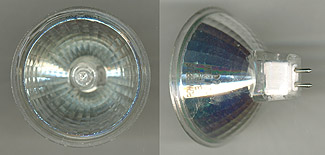 |
I have had useful service from these "downlighter" lamps, when embedded in a old mustard jar and filled with epoxy potting compound. Electrically, they are probably identical to the G4 above, except that their pins are a bit thicker, slightly further apart (5 mm) and cemented (concreted) into the dichroic reflector. They do produce a rather narrow beam and can generate hot-spots if you have a wide-angle camera. £2.00 each |
If you try to solder to the pins on these lamps you will almost certainly fail. Use crimp connectors, screw connecters out of small connector blocks, or the proper lamp holder if you can find one at a reasonable price. If you touch the glass envelope of a tungsten halogen lamp with your bare fingers, your fingerprints will be cooked onto the glass when you switch it on, and contribute to the early demise of the lamp. Prints may be removed with alcohol / meths / lens-cleaner.
HOME MADE UNDERWATER LAMP
UNIT
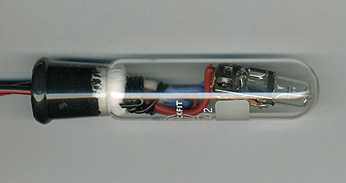 |
This is a higher output model I put together using a motor car headlamp bulb. It is rated at 12 volts 60 watts although other wattages are available. Heavy duty cable was attached to the short leads from the bulb and it was then placed into the strong glass test tube. Cotton wool was then packed into the tapered neck of the tube and impregnated with epoxy resin potting compound. Properly mixed, this sets rock hard into a tapered plug which is good to 250 metres. Now buy the heavy cable you need to avoid all that volt-drop. |
ADAPTORS
You can't live without them!
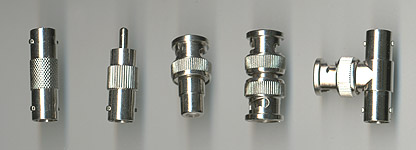 |
Here is a small selection of what is
available. All at £1 each. These change the end of that signal
cable from what it is
into what you want it to be.
Full list coming soon. |
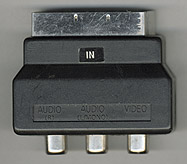 |
How on earth do you connect your composite
video signal into that nifty little video recorder you just got from
the electrical store? You need one of these scart to RCA adaptors. This
one, with the word IN on it, is for getting signals into the recorder
(or other scart equipped device). To get a video or audio signal out of
such a device, you need a different scart adaptor with the word OUT on
it.
£3 each |
OK - you have stuff I need. How do I get it?
First, please contact me  , with your requirements and your location. I
will check the shipping weights, work out the charges, and tell you
what delivery and payment options there are available. Usually PAYPAL
is a very efficient method, and almost immediate. CASH $,E and £
works well too. Within the UK, Postal Orders are good but cheques
really do
take 20 working days to clear - ask your bank!
, with your requirements and your location. I
will check the shipping weights, work out the charges, and tell you
what delivery and payment options there are available. Usually PAYPAL
is a very efficient method, and almost immediate. CASH $,E and £
works well too. Within the UK, Postal Orders are good but cheques
really do
take 20 working days to clear - ask your bank!
Any items not in stock will
usually be available for dispatch within three working days.
This is just the beginning
of the
list.
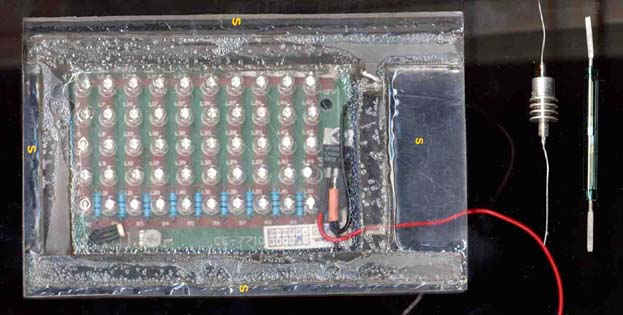 |
This picture shows one version of a waterproof 12 volt infra-red illuminator containing 50 diodes, during construction. The magnetic reed relay (extreme right) and the power dioide to provide polarity switching were later potted in the thick acrylic "Perspex" case. It is ugly but it works. PCB with diodes fully assembled available for £125.00 |
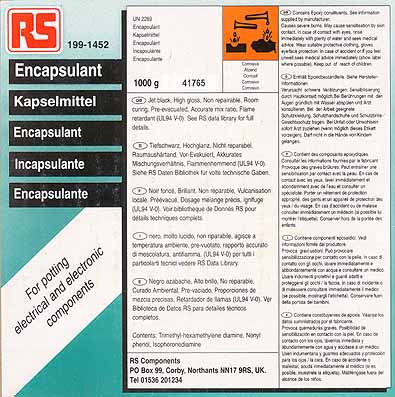 |
This is the potting compound I prefer. I have tried others, including the clear material which smells like glass-fibre resin, with poor results. This is black in colour and should be handled in accordance with the instructions. Definitely not for kids. It can be ordered online from the RS web site. If you foresee problems with the quantities you might be using, ask me how I got round them. |